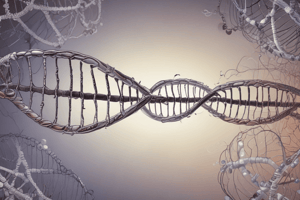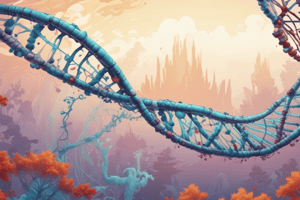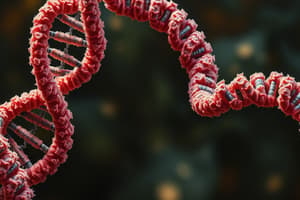Podcast
Questions and Answers
What is the primary role of splicing in gene expression?
What is the primary role of splicing in gene expression?
- To enhance the binding of transcription factors
- To remove non-coding sequences from pre-mRNA (correct)
- To catalyze the formation of spliceosome
- To produce multiple protein isoforms from a single gene
Which component is primarily responsible for catalyzing the splicing process?
Which component is primarily responsible for catalyzing the splicing process?
- RNA-binding proteins
- snRNA molecules
- The spliceosome (correct)
- Transcription factors
What mechanism allows for the removal of an entire exon during alternative splicing?
What mechanism allows for the removal of an entire exon during alternative splicing?
- Exon skipping (correct)
- Exon inclusion/exclusion
- Alternative splice site selection
- In-frame alternative splicing
How does alternative splicing contribute to protein diversity?
How does alternative splicing contribute to protein diversity?
Which of the following factors can regulate alternative splicing?
Which of the following factors can regulate alternative splicing?
What is the significance of the lariat structure formed during splicing?
What is the significance of the lariat structure formed during splicing?
What type of alternative splicing involves a change at the beginning or end of the protein-coding region?
What type of alternative splicing involves a change at the beginning or end of the protein-coding region?
Which of the following best describes alternative splicing?
Which of the following best describes alternative splicing?
Flashcards
RNA Splicing
RNA Splicing
The process of removing non-coding sequences (introns) from pre-mRNA, leaving only coding sequences (exons) to form mature mRNA.
Introns
Introns
Non-coding sequences within a gene that are removed during splicing.
Exons
Exons
Coding sequences within a gene that are joined together to form mature mRNA.
Spliceosome
Spliceosome
Signup and view all the flashcards
Alternative Splicing
Alternative Splicing
Signup and view all the flashcards
Splicing Factors
Splicing Factors
Signup and view all the flashcards
Environmental Factors
Environmental Factors
Signup and view all the flashcards
Protein Isoforms
Protein Isoforms
Signup and view all the flashcards
Study Notes
Introduction to Splicing
- Splicing is a crucial step in gene expression.
- It involves the removal of non-coding sequences (introns) from pre-mRNA molecules.
- Introns are interspersed within coding sequences (exons).
- The remaining exons are joined together to form mature mRNA.
- This mature mRNA serves as a template for protein synthesis.
The Splicing Process
- Splicing is catalyzed by a large complex of proteins and small nuclear RNAs (snRNAs) called the spliceosome.
- The spliceosome recognizes specific sequences at the 5' and 3' splice sites of introns.
- Key splicing steps include:
- Spliceosome recognition of splice sites.
- Formation of a lariat structure at the intron's 5' splice site.
- Excision of the intron as a lariat structure.
- Joining the two exons together.
Alternative Splicing
- Alternative splicing is a process where a single gene produces multiple different mRNA molecules.
- Different combinations of exons are joined together during splicing.
- This results in proteins with different structures and functions from the same gene.
- It's a major mechanism for increasing protein diversity encoded in a genome.
Mechanisms of Alternative Splicing
- Alternative splicing events occur through various mechanisms:
- Exon skipping: An exon is removed entirely.
- Exon inclusion/exclusion: Different combinations of exons are included or excluded.
- Alternative 5' or 3' splice site selection: Different splice sites are used, altering the protein-coding region's start or end.
- In-frame alternative splicing: An in-frame insertion or deletion in the protein sequence, potentially changing the protein's function.
Regulation of Alternative Splicing
- Alternative splicing regulation is complex, often controlled by:
- Specific splicing factors: Proteins that bind to pre-mRNA and influence splice site selection.
- Transcription factors: Factors that bind to DNA, influencing the expression of splicing factor genes.
- RNA-binding proteins: Proteins that bind to mRNA and influence splicing outcomes.
- Environmental factors: External factors affecting splicing patterns.
Biological Significance of Alternative Splicing
- Multiple protein isoforms from a single gene increase protein diversity and allow for complex proteomes.
- This facilitates cell type-specific protein production.
- It plays a key role in development, differentiation, and disease.
Impact of Alternative Splicing on Diseases
- Dysregulation of alternative splicing can lead to various diseases.
- Mutations in splicing factor genes result in aberrant splicing patterns.
- Splicing errors significantly affect protein production, potentially causing misfolded proteins or loss of crucial isoforms.
- Aberrant alternative splicing is linked to a wide range of human diseases, including neurological disorders, cardiovascular diseases, and cancers.
Studying That Suits You
Use AI to generate personalized quizzes and flashcards to suit your learning preferences.




